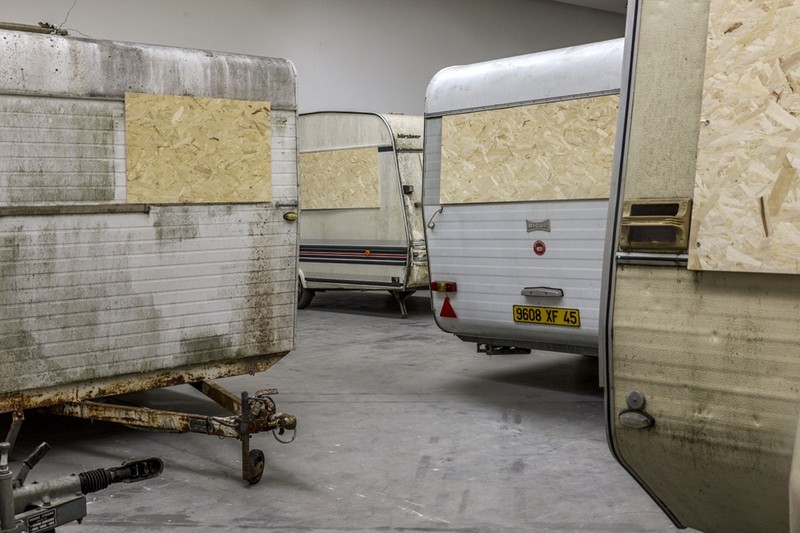Héctor Zamora
13 Jun - 11 Oct 2015
HÉCTOR ZAMORA
La réalité et autres tromperies (The reality and other deceptions)
13 June - 11 October 2015
For his solo exhibition, Héctor Zamora brings no less than seventeen caravans into the large hall of the Frac des Pays de la Loire, the maximum number in line with safety standards; seventeen caravans whose openings have been blocked by planks of wood, forming a labyrinthine and oppressive camp through which visitors are invited to make their way, the only thing on the horizon being the next caravan. Héctor Zamora thereby causes a rift between the overflowing exhibition space and the emptiness of the meadow surrounding the FRAC, neutralises the distance usually observed with respect to artworks while obstructing the view, and gives the visitor a feeling of disorientation and suffocation. In this way, the Mexican artist provides his take on a tough topic ever-present in France nowadays – namely occupations and deportations, lives reduced to vagrancy, elusive to our eyes.
Also on public view in the Nantes Galeries Lafayette is Brasil, a crazy bicycle with a brick wall precariously balanced on it – one of Héctor Zamora’s favourite materials as well as a basic element of the local architecture. The work is as much a tribute to the sense of balance of Brazilian builders as a metaphor for the flimsy construction represented by Brazil itself.
At the boundaries of sculpture and architecture, Mexican artist Héctor Zamora (born in 1974, lives and works in Sao Paulo, Brazil) transcends the conventional exhibition space, constantly redefining and reinventing it to generate a form of friction between private and public, exterior and interior, organic and geometric, wild and orderly, real and imaginary spheres.
Drawing on an architectural idiom and techniques, Héctor Zamora makes use of simple, paltry materials, such as sheet metal, bricks, tarpaulins, tyres, canisters and items such
as caravans, shacks and awnings – recurrent items in the makeshift dwellings found on the outskirts of cities in Latin America or Europe – to produce light and ephemeral organic structures that strike a chord with the places surrounding them. Meticulous and ever attentive to his adopted context, its history, configuration, and social and political organisation, Zamora calls on the viewer’s participation, raising questions about the everyday uses of the places in which we live, constantly seeking to subvert and shed light on them, even to change their modus operandi. A skilful tactician, he plays with the institution’s possibilities, constraints and weaknesses in order to make space for freedom in action, to spark reactions.
Text: Julien Zerbone
La réalité et autres tromperies (The reality and other deceptions)
13 June - 11 October 2015
For his solo exhibition, Héctor Zamora brings no less than seventeen caravans into the large hall of the Frac des Pays de la Loire, the maximum number in line with safety standards; seventeen caravans whose openings have been blocked by planks of wood, forming a labyrinthine and oppressive camp through which visitors are invited to make their way, the only thing on the horizon being the next caravan. Héctor Zamora thereby causes a rift between the overflowing exhibition space and the emptiness of the meadow surrounding the FRAC, neutralises the distance usually observed with respect to artworks while obstructing the view, and gives the visitor a feeling of disorientation and suffocation. In this way, the Mexican artist provides his take on a tough topic ever-present in France nowadays – namely occupations and deportations, lives reduced to vagrancy, elusive to our eyes.
Also on public view in the Nantes Galeries Lafayette is Brasil, a crazy bicycle with a brick wall precariously balanced on it – one of Héctor Zamora’s favourite materials as well as a basic element of the local architecture. The work is as much a tribute to the sense of balance of Brazilian builders as a metaphor for the flimsy construction represented by Brazil itself.
At the boundaries of sculpture and architecture, Mexican artist Héctor Zamora (born in 1974, lives and works in Sao Paulo, Brazil) transcends the conventional exhibition space, constantly redefining and reinventing it to generate a form of friction between private and public, exterior and interior, organic and geometric, wild and orderly, real and imaginary spheres.
Drawing on an architectural idiom and techniques, Héctor Zamora makes use of simple, paltry materials, such as sheet metal, bricks, tarpaulins, tyres, canisters and items such
as caravans, shacks and awnings – recurrent items in the makeshift dwellings found on the outskirts of cities in Latin America or Europe – to produce light and ephemeral organic structures that strike a chord with the places surrounding them. Meticulous and ever attentive to his adopted context, its history, configuration, and social and political organisation, Zamora calls on the viewer’s participation, raising questions about the everyday uses of the places in which we live, constantly seeking to subvert and shed light on them, even to change their modus operandi. A skilful tactician, he plays with the institution’s possibilities, constraints and weaknesses in order to make space for freedom in action, to spark reactions.
Text: Julien Zerbone

